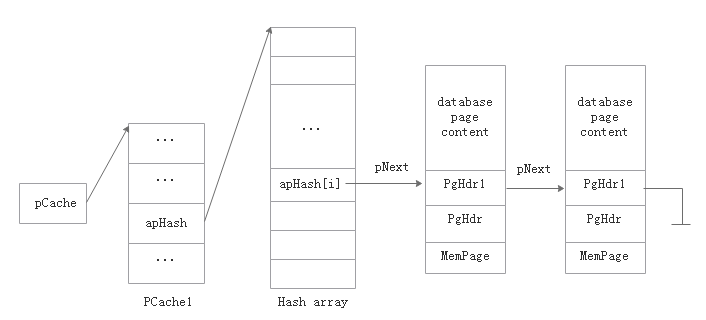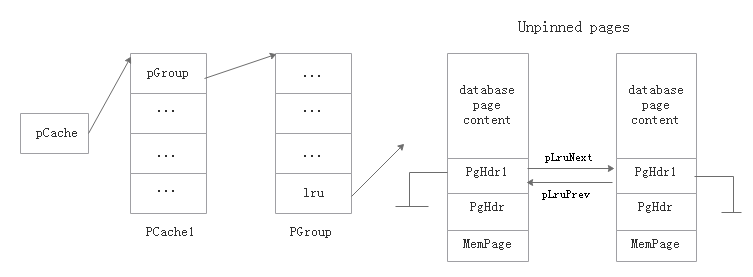SQLite3原始碼學習(21) pcache1分析
學習本章之前要先複習以下2篇文章:
之前講到page cache是一種可插入式的管理方式,在sqlite3GlobalConfig.pcache2裡定義了對page cache管理的一系列方法介面,並且介紹了最簡單的一種介面testpcache,現在我們來分析一下預設的介面pache1,這個要比testpcache複雜很多。
1.記憶體結構
一個page cache在記憶體中按如下格式儲存,由資料內容和頭部組成:
其中PgHdr1在pcache1.c裡定義,PgHdr在pcache.c裡定義,MemPage在btree.c裡定義,在新建一個頁時,上述內容由sqlite3_pcache_page
struct sqlite3_pcache_page {
void *pBuf; /* The content of the page */
void *pExtra; /* Extra information associated with the page */
};其中pBuf指向database page content和PgHdr1,pExtra指向PgHdr和MemPage,另外在PgHdr1結構體裡定義了一個sqlite3_pcache_page物件。
struct PgHdr1 { sqlite3_pcache_page page; /* Base class. Must be first. pBuf & pExtra */ …… };
新建一個page cache時程式碼如下:
pPg = pcache1Alloc(pCache->szAlloc);
p = (PgHdr1 *)&((u8 *)pPg)[pCache->szPage];
p->page.pBuf = pPg;
p->page.pExtra = &p[1];2.結構關係
hash表
每一次呼叫pcache1的介面時,需要傳入一個sqlite3_pcache*型別的物件作為連線控制代碼,在pcache1中被轉換為PCache1*型別。
有些時候還需要傳入頁面物件作為引數,傳入時的型別是sqlite3_pcache_page*
在PCache1*型別的物件中有一張hash表,所有的page cache都存放在這張hash表裡,如果page cache的key值對應的hash表的索引相同,那麼相同地址的元素再建立一個連結串列。
在Pcache1中與hash表相關變數如下:
struct PCache1 {
……
int szPage; /* Size of database content section */
int szExtra; /* sizeof(MemPage)+sizeof(PgHdr) */
//即szPage+szExtra+sizeof(PgHdr1)
int szAlloc; /* Total size of one pcache line */
……
//hash表中最大的關鍵字,即最大的頁面序號
unsigned int iMaxKey; /* Largest key seen since xTruncate() */
//包括hash表元素和所有連結串列元素的總個數
unsigned int nPage; /* Total number of pages in apHash */
//即apHash陣列的長度
unsigned int nHash; /* Number of slots in apHash[] */
PgHdr1 **apHash; /* Hash table for fast lookup by key
};PGroup
我們把存放page cache的地址稱作slot,那麼上節講到的hash表就把這些slot很好地組織在了一起,從而更容易查詢對應的快取頁。
這些需要經常用到的頁快取我們把它標記為pinned,不常用的快取頁我們把它標記為unpinned。我們還可以通過一種叫做PGroup的方式把這些unpinned slot組織在一起,這個是LRU演算法的基礎。也就是說當快取頁數量已經達到最大時,需要清理掉一些不常用的快取頁來增加新的快取頁。
PGroup的實現有2種模式:
模式1:
每一個連線的PCache擁有自己獨立的PGroup,這個時候不需要加鎖,訪問速度更快,但是佔用的記憶體空間更大。
模式2:
所有連線的PCache共有一個PGroup,也就是說所有PCache的unppined page組成一個PGroup,這時候PGroup屬於多執行緒中的共享資源,需要加鎖,所以速度慢一點,但是這種模式可以回收利用更多的記憶體空間。
PGroup的構建方式如下圖所示:
所有的unpinned page組成一個雙向的迴圈連結串列,pGroup->lru作為這個連結串列的表頭。其實這相當於一個佇列,新插入的page加入到佇列頭部,在佇列尾部的page是最早的,所以回收時先回收佇列尾部的page。用迴圈列表就不用查詢操作,只要知道了pGroup->lru,就能定位到佇列的頭部和尾部。
pGroup相關資料結構如下:
struct PCache1 {
/* Cache configuration parameters. Page size (szPage) and the purgeable
** flag (bPurgeable) are set when the cache is created. nMax may be
** modified at any time by a call to the pcache1Cachesize() method.
** The PGroup mutex must be held when accessing nMax.
*/
PGroup *pGroup; /* PGroup this cache belongs to */
……
/* 如果該值為0,那麼該PCache的所有page都不可回收利用 */
int bPurgeable; /* True if cache is purgeable */
//每個PCache預留的slot數量,當前為10
unsigned int nMin; /* Minimum number of pages reserved */
//每個PCache配置的最大slot數量
unsigned int nMax; /* Configured "cache_size" value */
unsigned int n90pct; /* nMax*9/10 */
unsigned int nRecyclable; /* Number of pages in the LRU list */
……
};
struct PGroup {
//在模式1時鎖為空
sqlite3_mutex *mutex; /* MUTEX_STATIC_LRU or NULL */
//所有pCache.nMax之和
unsigned int nMaxPage; /* Sum of nMax for purgeable caches */
//所有pCache.nMin之和
unsigned int nMinPage; /* Sum of nMin for purgeable caches */
//在createFlag==1時,最大使用的slot數量
//預留nMaxpage- mxPinned= nMinPage-10數量的slot
unsigned int mxPinned; /* nMaxpage + 10 - nMinPage */
unsigned int nCurrentPage; /* Number of purgeable pages allocated */
PgHdr1 lru; /* The beginning and end of the LRU list */
};3.記憶體申請
在page cache中,申請記憶體主要由以下3種方式:
1.PCache-local bulk分配器
這個針對pGroup的模式1,也就是先申請一個大的zBulk空間,然後將其分割成一個個slot,每個slot按照記憶體結構關係定義好,再把這些slot組成一個連結串列,使用時只要從頭部摘下即可,不用了放回頭部。
2.頁快取記憶體分配器
這個針對pGroup的模式2,預設時是關閉的,需要呼叫 sqlite3_config(SQLITE_CONFIG_PAGECACHE, pBuf, sz, N)介面來配置
其中pBuf是申請的空間地址,sz是slot大小,N是slot個數,申請的空間再通過sqlite3PcacheBufferSetup()函式配置,這裡也是把一大塊地址分割成許多個slot再組成連結串列,放到pcache1.pFree,但是slot的格式並沒有定義,這是因為針對不同的PCache,每個頁快取的szAlloc可能會有所不同。
3.普通記憶體分配器
當以上2種方式都沒有申請到記憶體時,呼叫sqlite3Malloc()
4.Page的讀取
如果pGroup是模式1,那麼呼叫pcache1FetchWithMutex()加鎖,如果pGroup是模式2,那麼直接呼叫pcache1FetchNoMutex()。
讀取一個page按照以下流程:
1.根據頁號(iKey)搜尋hash表
static PgHdr1 *pcache1FetchNoMutex(
sqlite3_pcache *p,
unsigned int iKey,
int createFlag
){
……
PCache1 *pCache = (PCache1 *)p;
PgHdr1 *pPage = 0;
pPage = pCache->apHash[iKey % pCache->nHash];
while( pPage && pPage->iKey!=iKey ){ pPage = pPage->pNext; }
……
}2.如果頁面找到了,那麼返回這個頁面;如果沒找到,並且createFlag是0,那麼返回異常;如果沒找到,但是createFlag不為0,繼續以下步驟。
3.如果createFlag==1,並且使用的page已經超過最大限制,或者記憶體緊缺,那麼直接返回0。
unsigned int nPinned;
PGroup *pGroup = pCache->pGroup;
if( createFlag==1 && (
nPinned>=pGroup->mxPinned
|| nPinned>=pCache->n90pct
|| (pcache1UnderMemoryPressure(pCache) && pCache->nRecyclable<nPinned)
)){
return 0;
}
因為通常步驟3以後是不需要的,所以把以後的步驟單獨放在pcache1FetchStage2()函式裡,並且設定強制不內聯,以減少函式堆疊的初始化,加快讀取速度。
4.如果滿足條件,回收利用unpinned page
if( pCache->bPurgeable//可回收
//迴圈連結串列的表頭不能被回收
&& !pGroup->lru.pLruPrev->isAnchor
//當使用的page超過了設定的最大值或者記憶體不足才回收
&& ((pCache->nPage+1>=pCache->nMax) || pcache1UnderMemoryPressure(pCache))
){
PCache1 *pOther;
pPage = pGroup->lru.pLruPrev;//回收佇列尾部的page
assert( pPage->isPinned==0 );
pcache1RemoveFromHash(pPage, 0);//把它從原來的hash表中移除
pcache1PinPage(pPage);//標記為pinned
pOther = pPage->pCache;
if( pOther->szAlloc != pCache->szAlloc ){
//回收的slot長度不符合要求
pcache1FreePage(pPage);
pPage = 0;
}else{
//其實相當於bPurgeable為0,那麼nCurrentPage++
pGroup->nCurrentPage -= (pOther->bPurgeable - pCache->bPurgeable);
}
}5.經過上面步驟還沒找到page,那麼重新申請一個page cache
5.函式說明
void sqlite3PCacheBufferSetup(void *pBuf, int sz, int n)
配置頁快取記憶體分配器。
static int pcache1InitBulk(PCache1 *pCache)
初始化bulk記憶體分配器
static void *pcache1Alloc(int nByte)
為一個快取頁申請nByte大小的空間,先使用頁快取記憶體分配器,如果記憶體不夠分配,再使用通用記憶體分配器。
static void pcache1Free(void *p)
釋放快取頁
static int pcache1MemSize(void *p)
獲取申請記憶體的長度
static PgHdr1 *pcache1AllocPage(PCache1 *pCache, int benignMalloc)
建立一個新的快取頁,如果不是通過bulk記憶體分配器獲得記憶體,那麼需要對申請的slot定義快取頁的記憶體結構
void *sqlite3PageMalloc(int sz)
pcache1Alloc()的一個對外介面
static void pcache1FreePage(PgHdr1 *p)
pcache1Free()的一個對外介面
static void pcache1ResizeHash(PCache1 *p)
當pCache->nPage>=pCache->nHash時,把hash表長度擴大1倍,並重新調整hash表結構
static PgHdr1 *pcache1PinPage(PgHdr1 *pPage)
把剛建立或剛回收的快取頁標記為pinned
static void pcache1RemoveFromHash(PgHdr1 *pPage, int freeFlag)
將pPage從hash表中移除,如果freeFlag置1,那麼釋放記憶體
static void pcache1EnforceMaxPage(PCache1 *pCache)
如果pGroup->nCurrentPage>pGroup->nMaxPage,那麼移除LRU佇列中多餘的page
static void pcache1TruncateUnsafe(
PCache1 *pCache,/* The cache to truncate */
unsigned int iLimit/* Drop pages with this pgno or larger */
)
釋放頁號大於iLimit的頁,如果pCache->iMaxKey - iLimit < pCache->nHash,那麼不用掃描整個hash表,否則從pCache->nHash/2處開始掃描整個hash表。
static int pcache1Init(void *NotUsed)
設定PGroup模式,如果是模式2,初始化鎖。
static sqlite3_pcache *pcache1Create(int szPage, int szExtra, int bPurgeable)
建立一個pCache,並初始化相關引數
static void pcache1Cachesize(sqlite3_pcache *p, int nMax)
設定pCache->nMax
static void pcache1Shrink(sqlite3_pcache *p)
把所有unpinned page都釋放掉
static int pcache1Pagecount(sqlite3_pcache *p)
獲得當前快取頁的數量
static SQLITE_NOINLINE PgHdr1 *pcache1FetchStage2(
PCache1 *pCache,
unsigned int iKey,
int createFlag
)
讀取快取頁,見上節分析
static PgHdr1 *pcache1FetchNoMutex(
sqlite3_pcache *p,
unsigned int iKey,
int createFlag
)
讀取快取頁,見上節分析
static PgHdr1 *pcache1FetchWithMutex(
sqlite3_pcache *p,
unsigned int iKey,
int createFlag
)
讀取快取頁,需要先加鎖
static sqlite3_pcache_page *pcache1Fetch(
sqlite3_pcache *p,
unsigned int iKey,
int createFlag
)
讀取快取頁的對外介面
static void pcache1Unpin(
sqlite3_pcache *p,
sqlite3_pcache_page *pPg,
int reuseUnlikely
)
把page插入到LRU佇列裡
static void pcache1Rekey(
sqlite3_pcache *p,
sqlite3_pcache_page *pPg,
unsigned int iOld,
unsigned int iNew
)
重新設定page的頁號
static void pcache1Truncate(sqlite3_pcache *p, unsigned int iLimit)
加鎖後再呼叫pcache1TruncateUnsafe()
static void pcache1Destroy(sqlite3_pcache *p)
釋放pCache中的所有頁
void sqlite3PCacheSetDefault(void)
設定pcache1的對外介面到sqlite3GlobalConfig.pcache2
int sqlite3PcacheReleaseMemory(int nReq)
從PGroup裡釋放nReq大小的空間



